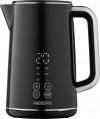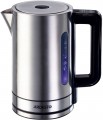Water level indicator
A device that allows you to estimate the amount of water in the kettle without opening its lid. Most often
the water level indicator has the form of a scale applied either to the transparent wall of the container, or to a transparent insert in an opaque wall. In any case, this function allows you to measure the volume of filled water quite accurately, and not just determine it “by eye”. This possibility is especially important for models with open coils (see "Heating element"), in such devices, a mark on the indicator is usually applied to the minimum allowable water level.
Temperature adjustment
The temperature adjustment capabilities refer to the specific temperature values that can be programmed into the electric kettle. It's important to note that this refers to automatic adjustment, where the kettle turns off or switches to temperature maintenance mode once the desired temperature has been reached.
If this paragraph contains several options separated by commas (for example, “60 °С, 80 °С, 90 °С”), this means that this model has several fixed temperature options. However, there are also devices with
smooth adjustment, which allows you to adjust the temperature in steps of 5 °C, or even 1 °C; for such devices, the entire adjustment range is indicated here, for example, "60 — 100 °C".
The greater the number of temperature setting options available in an electric kettle, the more versatile it becomes, allowing for precise selection of the optimal brewing mode for various types of drinks. Here is a simple table of recommended temperatures:
—
white tea — 60 °C;
—
yellow tea -70 °C;
—
green tea — 80 °C;
—
black tea — 90 °C;
— rooibos, hibiscus — 100 °C (up to boiling);
—
baby food — 40 °C.
Of course, there are exceptions to such rules — depending on the specific type of drink. For example, some
...varieties of green tea can be brewed at 90 °C.Thermometer
A device that displays the temperature of the water in the kettle. The presence of a
thermometer is useful if the water needs to be heated to a certain temperature. However, the thermometer does not automatically turn off the kettle, unlike a thermostat — this must be done manually. Also, the thermometer allows you to assess how much the heated water has cooled over time and whether it can be used without heating again.
Body shape
The general shape of the body of the electric kettle.
—
Conical. The most popular option: a body is wide at the base and tapering upwards. This form contributes to stability: the centre of gravity is maximally displaced downwards. However washing such a kettle from the inside may not be very convenient due to the relatively small size of the opening in the upper part.
—
Cylindrical. The cylindrical shape provides more or less the same width of the body at the base and at the top. With the same height and base diameter, such kettles hold slightly more water than conical ones; in addition, such a device is easier to clean due to the wide opening for the lid.
—
Inclined. The body which is inclined forward; the width of such a body is usually more or less the same over the entire height. Such kettles have an unusual, eye-catching appearance; in addition, it is easier to pour water from them — the device must be inclined at a smaller angle than with a cylindrical and even with a conical body. However, this option does not provide fundamental advantages over the same cylindrical shape, but it is more expensive, and therefore is not common.
Double-walled
Double-walled are found mainly among traditional electric kettles.
This design performs several functions at once. First of all, it significantly improves thermal insulation, allowing the kettle to retain heat longer and save energy when heating. Also, double-walled increase strength and reliability — it is more difficult to break through such a wall or noticeably damage it than a single one. And in some models, the outer side is made of plastic, and the inner side is made — of metal; this allows you to combine the advantages of both materials without a significant increase in cost.
Display
The own
display noticeably simplifies and facilitates the use of the kettle. Most often, this is the simplest single-colour screen, capable of displaying 2 — 3 figures and possibly the individual special symbols — however, in this case, more is not required. The display is especially convenient when selecting and controlling the heating temperature — after all, it is much more convenient to navigate by specific numbers than by simpler devices like colour indicators. Actually, the presence of a screen almost 100% guarantees that this model is also equipped with a thermostat.
Controller
The name of the controller installed in the device.
The controller is called an electronic circuit, which is directly responsible for managing the operation — primarily for turning off the heating when boiling or turning on without water. In our catalog, the name of such a circuit is specified if we are talking about an advanced controller that significantly exceeds most solutions on the market in terms of quality and reliability. At the same time, the specs indicate not a specific model, but a general brand — this is quite enough in this case.
The most reliable, durable and safe nowadays are the controllers of the British manufacturers Strix and Otter. There are no fundamental differences between these options in this regard, any of them is a sign of a quality kettle (even if the overall functionality of the device is rather modest). On the other hand, such equipment affects the price.
Material
The main material of the kettle.
Note that this paragraph primarily considers external material; the inner coating may differ from it. As for specific options,
metal (usually steel),
plastic and
glass products are the most popular nowadays. More rare are
glass with metal and
ceramics (including porcelain). Here is a more detailed description of the different materials:
— Steel. Stainless steel is a popular material for kettles due to its strength, stylish appearance, and non-corrosive properties. It is available in a wide range of price categories. However, steel's high thermal conductivity may increase energy consumption and create a risk of burns. Steel is also opaque, so transparent inserts are necessary to monitor water levels. It is not suitable for teapots as it can give an extraneous aftertaste to the drink.
— Plastic. Plastic kettles are inexpensive and can be produced in various colors and transparency. They have low thermal conductivity, which reduces the risk of burns when touched. However, plastic is prone to scratches and can fade over time. Inexpensive plastic models may emit an unpleasant smell and taste when heated, but higher-priced models may use better quality plastic or have a metal lining to prevent this issue. Some high-end plastic materials are available b
...ut cost more.
— Glass. Glass kettles have a visually appealing and transparent appearance, allowing you to easily monitor the water level without any special indicators. This is especially useful for teapots, as it enables the user to monitor the colour and saturation of the tea during the brewing process. Glass containers do not affect the taste or smell of the drink, which is highly beneficial for tea drinkers. Although glass is considered fragile, it is difficult to break such a container in reality. However, one of the downsides of glass containers is that any scale or contaminants inside the container are easily visible from the outside, requiring extra care to maintain their appearance. The thermal conductivity of glass is average, making it less prone to heat transfer than steel, but more so than many types of plastic. Therefore, touching a heated glass kettle should be avoided to prevent the risk of burns.
It should be noted that glass kettles often have parts made of materials other than glass. Usually, the top and bottom, as well as the handle, are made of plastic or a combination of plastic and metal. However, if these parts are mostly made of metal, the material is referred to as "glass with metal."
— Glass with metal. There are glass kettles that have metal top and bottom parts, with only a plastic insert in the lid for convenience purposes. These teapots are considered more advanced than the regular glass models that use plastic, as metal adds a sense of solidity and enhances durability. Also, since the contents of the kettle do not come into contact with plastic, the possibility of foreign tastes and odors is almost non-existent. However, such teapots are relatively expensive, although there are also affordable options available.
— Ceramics. Ceramics have a distinct advantage in terms of aesthetics as they offer a stylish appearance, making them an ideal choice for retro-style kettles or those with a classic design. Moreover, they are usually adorned with unique patterns and designs. Apart from their appearance, ceramic kettles do not affect the taste of the contents and provide excellent heat retention due to their thick walls. However, they are heavy and vulnerable to shocks, their opaque cases make it difficult to check water levels without opening the lid, and they lack water level indicators. Therefore, if appearance is a priority, ceramics can be an attractive option despite these drawbacks.
— Porcelain. Porcelain is a type of ceramic material that is highly valued for its prestigious appearance and is considered expensive. However, it is also fragile and requires delicate handling, which is why it is not commonly used in electric kettles.
